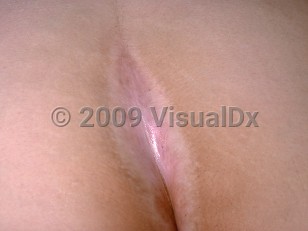Lichen sclerosus - Anogenital in
See also in: Overview,External and Internal EyeAlerts and Notices
Important News & Links
Synopsis

In children, it is the most common skin condition mistaken for sexual abuse. Although onset is typically around 35-45 years of age, about 7%-15% of cases begin in childhood.
LS may be asymptomatic, although it often results in pruritus and burning. Additionally, there may pain on defecation, constipation, dysuria, or anal or genital bleeding. A major goal of treatment for male pediatric anogenital LS is to prevent urethral stricture.
Children may seek parental attention. They may also present with behavioral changes; for example, caregivers (teachers, parents) may describe a child as "always having their hands in their pants," "rubbing on everything," and "unable to sit still." Behavior caused by itching may be misinterpreted as masturbation that is persistent and resistant to requests to stop.
Misdiagnosis for sexual abuse most often occurs when the presentation is bullous, hemorrhagic, or erosive. Submucosal hemorrhages ("blood blisters") are rarely due to sexual abuse and are a common finding in LS. The presence of hypopigmentation, atrophic skin, and telangiectasias should help differentiate this condition from sexual maltreatment. Findings of confirmed sexual abuse are primarily associated with acute injuries to the genitalia, anus, or oral cavity, genital scarring, sexually transmitted diseases, or evidence of a deep notch. Case reports of LS coexisting with child abuse have been documented.
Childhood sexual abuse can affect children of all ages and economic and cultural backgrounds. Practitioners working with this population should consider this diagnosis routinely. Childhood sexual abuse is a serious allegation with major repercussions to a child and their family, and the differential diagnosis of genital lesions suggestive of sexual abuse includes LS and other anogenital dermatoses.
Genital LS confers a small risk of squamous cell carcinoma (SCC).
Codes
L90.0 – Lichen sclerosus et atrophicus
SNOMEDCT:
895454001 – Lichen sclerosus
Look For
Subscription Required
Diagnostic Pearls
Subscription Required
Differential Diagnosis & Pitfalls

Subscription Required
Best Tests
Subscription Required
Management Pearls
Subscription Required
Therapy
Subscription Required
Drug Reaction Data
Subscription Required
References
Subscription Required
Last Updated:03/09/2023
 Patient Information for Lichen sclerosus - Anogenital in
Patient Information for Lichen sclerosus - Anogenital in - Improve treatment compliance
- Reduce after-hours questions
- Increase patient engagement and satisfaction
- Written in clear, easy-to-understand language. No confusing jargon.
- Available in English and Spanish
- Print out or email directly to your patient



